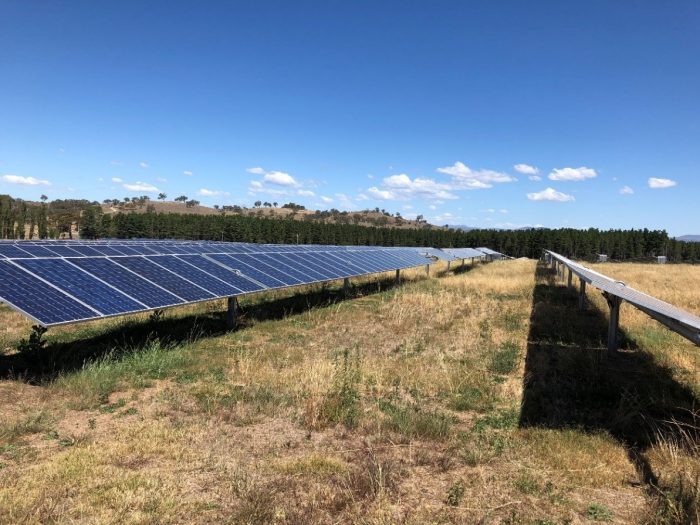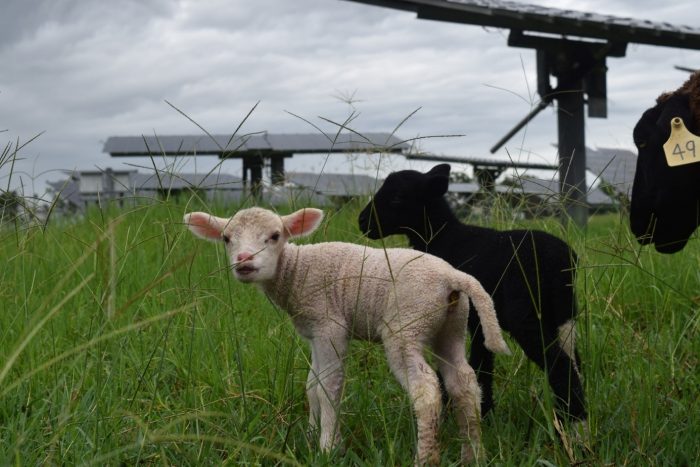
Solar Farms (large arrays of panels of photo-voltaic cells) have been established across NSW to provide alternative electrical energy sources for residential and industrial use and more are being planned and built.
Individual panels may be fixed or tracking – that is, built at a fixed angle to the land surface or able to track the sun over the course of the day. Currently, the upper edges of the fixed panels are typically around 3.5 metres above the ground, while the tracking panels move between 3.1 and 4.5 metres in height. For each type, the bottom edge is about 0.3 metres or more above the ground.

Mount Majura Solar Farm, near Canberra, operational since October 2016 (photo – Dave Walker).
Solar farm developments often provokes concerns of neighbours for visual disturbance and other impacts, and in some cases for the perceived alienation of prime agricultural land. The effects of the panels on rainfall water runoff, soil erosion, soil properties and the micro-environment below them have also been questioned.
Of particular interest to the Soil Knowledge Network are the effects of a changing runoff regime on soils and the potential for soil erosion.
Construction and operation of large Solar Farms require assessment as State Significant Projects under the NSW Environmental Planning and Assessment Act (1979) and therefore require Environmental Impact Studies and management plans. Smaller farms are assessed by Regional Planning Panels or by local Councils.
Soil and vegetation disturbance during construction may include levelling, drainage, excavation for foundations, poles and cabling, access ways and equipment storage. Management of these impacts is addressed in the above assessments and should follow soil conservation principles such as are found in the document Managing Urban Stormwater: Soils and Construction (Landcom 2004).
In the operational phase, issues that are addressed include changed micro-climate under and between panels (due to intermittent or complete shading, rainfall redistribution and changes in humidity); changes in vegetation species composition (due to the above); altered or increased runoff from rainfall falling on panels; and soil erosion (due to a concentrated dripline effect at the lower edge of the panels).
These issues are addressed in EIS documents for each proposal. These studies and the Determinations of the projects can be accessed on-line at: www.planningportal.nsw.gov.au>majorprojects.
Some EIS documents quote a paper by Cook and McCuen (2013) who modelled potential increased runoff rates from panels and found that solar panels did not have a significant effect on runoff volumes, peaks or time to peak, if vegetative groundcover under the panels was maintained. They also noted that peak discharge could increase significantly if the ground under the panels was bare or gravelled and that the increased erosive force of drips off the panels could cause erosion at the dripline. They recommend that the grass under the panels be maintained or that a vegetated buffer strip be grown downslope of each row of panels.
It is not clear whether land slope has a further effect, but most Solar Farms appear to be on level or near level land.
The mitigation measures proposed in EIS documents are basically:
- sow groundcover under and adjacent to the panels with a permanent pasture mix suitable for the region and for long-term grazing;
- control-graze the area to maintain groundcover density and sward height; and
- groundcover should be maintained at 80% (and in some cases 100%).

University of Queensland’s Gatton Solar Farm. Sheep graze full time. Operational since March 2015 (photo – Dave Walker).
This accords with traditional soil conservation principles and guidelines for protection of soils by ground cover. Further, maintenance of ground cover by carefully managed grazing should lead to an increase in soil organic matter, improvement of soil surface structure, increased water infiltration capacity, increased plant nutrients and increased soil biological activity.
References
Cook, L. and McCuen, R. (2013) Hydrologic Response of Solar Farms. J Hydrologic Engineering 18(5) 534-541.
Landcom (2004) Managing Urban Stormwater: Soils and Construction. Vol 1.

Soil Knowledge Network Position Statement
Solar farms
The Soil Knowledge Network supports in principle the development of Solar Farms (arrays of panels of photo-voltaic cells to generate electricity) on suitable land types.
The Soil Knowledge Network recommends that:
- the construction, operation and decommissioning of solar farms should not degrade the land, and after decommissioning, the land should be restored to its original capability to produce food or fibre;
- construction of Solar Farms should incorporate and adhere to a soil and water management plan compliant with the provisions in Managing Urban Stormwater: Soils and Construction (Landcom 2004);
- perennial groundcover should be established or retained and maintained under and around solar panel arrays; and
- groundcover in these areas should be maximised to protect the soil surface from water and wind erosion at all times, whilst taking appropriate action to address excessive buildup of fire fuel by controlled grazing or slashing.
Promoting the importance of soils through knowledge and expertise www.nswskn.com
